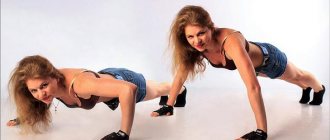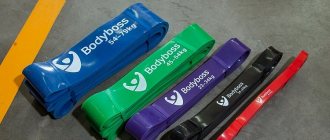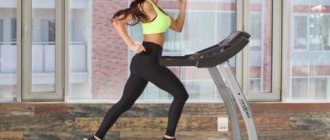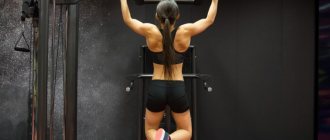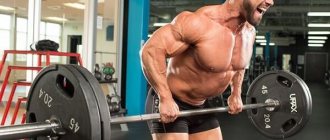How to pump up your lats
There are two types of wing loading:
1 Developing muscles in width. 2 Developing muscles in thickness.
There are separate exercises for each of these groups. It is worth remembering that wings are a fairly large muscle group, and to work them effectively you need to include exercises from both categories.
The lats are located on the back and occupy a significant part of it. This means that by performing basic back exercises such as deadlifts or bent-over rows, you will develop this muscle group. But there are others who purposefully develop wings.
Lat exercises to develop width are performed in the vertical plane. These include all types of pull-ups and vertical rows.
To develop thickness, use various types of dumbbell rows in an inclined and standing position, barbell rows and lower pulleys .
For width:
What are the benefits of lat training?
The latissimus dorsi muscles are called wings because in a good and developed state they look like the folded limbs of a large bird. We will explain the need to train this muscle group through the functions it performs:
- Bringing the shoulder towards the body.
- Pull both arms back.
- Moving the midline inward.
For a better understanding: the latissimus muscles helped our ancestors climb trees, pull themselves up, and pull something towards their body. They have a very important role and nature has allocated almost half of the entire back on the human body, if not more. This is where the power that wings can develop comes from.
The following picture clearly shows their location on the back:
Necessary sports equipment
You can pump up this muscle group both in the gym and at home. Standard sports equipment for developing wings is a barbell, dumbbells, benches, weights and special exercise machines. Naturally, most likely there is nothing of this at home - it doesn’t matter. One of the most effective exercises you can do on a street or home horizontal bar is wide-grip pull-ups. Dumbbells can be replaced with bottles of water or sand, and the bench with chairs or stools.
Let's move on to a review of effective exercises that will help you develop your latissimus muscles at home.
Pull-down of the upper block behind the head
Increases strength and allows you to build muscle mass in your lats. Effective for girls and beginners, as it allows you to strengthen your back before developing other muscle groups.
- Sit on the bench, set the desired weight.
- The bar is taken with an overhand grip.
- As you exhale, lower the bar behind your neck, approximately to the beginning of the trapezius level.
- As you inhale, return the bar to its original position. Don't forget about proper breathing.

Classic pull-ups
The exercise is rightfully considered the best for developing wing width. If it's easy for you to perform the required number of repetitions with your own weight, use additional weights in the form of plates or weights.
- Hang on the horizontal bar, straight grip, arms as wide as possible.
- As you exhale, pull yourself up, using only muscle strength - do not swing or jerk.
- Hold at the top for a second and slowly, as you exhale, lower down.
Pull-ups can also be done with a reverse grip. In this case, part of the load will be transferred to the biceps of the arms, which will make the exercise easier.
You can develop the width of the latissimus dorsi muscles both on simulators and exclusively on the horizontal bar.
For thickness:
Pathology
It is believed that the involvement of the levator scapulae muscle in various pathological processes is one of the common causes of painful “tightness” in the neck and shoulder girdle (the so-called “scapular-costal syndrome”). Along with this muscle, as a rule, the supraspinatus and anterior scalene muscles are affected.
The development of this pathological condition is facilitated by functional disorders - a consequence of overstrain of the muscles that fix the scapula or set it in motion.
Circumstances leading to the development of the syndrome:
- low level of mobility, physical inactivity;
- passive lifestyle;
- unusual intense loads (sudden jumps, lifting weights), which is especially important for untrained people whose muscles are not accustomed to physical activity;
- traumatic injuries (especially blows to the back, falls, road accidents).
Painful sensations in this pathology can be of a different nature and have different intensities (can be sharp, acute, or can be aching, bursting in nature; in some cases it takes a chronic course).
In acute cases, complex therapy is carried out, including:
- medicinal treatments designed to relieve pain and reduce spasms;
- physiotherapeutic procedures;
- massage (a massage course should be carried out outside of an exacerbation, after pain relief);
- special exercises.
The most effective preventive measure aimed at reducing the frequency and intensity of exacerbations is special therapeutic exercises. Systematic performance of simple exercises will strengthen the muscles, and the load will no longer cause pain in them.
Bent-over barbell row
It is a basic exercise and also the best for developing the thickness of the back muscles. To do it:
- Equip the barbell with the required weight and place it in front of you.
- Take it with a forward or reverse grip and stand up straight.
- Tilt your body forward to approximately 45 degrees. Keep your back straight - a natural arch in the lower back is allowed.
- Bend your knees slightly.
- As you exhale, pull the barbell towards your lower abdomen and hold it for a second.
- As you move up, try to squeeze your shoulder blades together as much as possible.
- As you inhale, straighten your arms with the barbell and lower it to your knees.
During movement, the bar rises exclusively in the vertical plane.

Bent-over dumbbell row
It can be performed similarly with a bent-over barbell row or alternately for each arm in different positions. Let's consider the classic option using a bench.
- Place the bench horizontally.
- Take a dumbbell with the required weight in your right hand.
- Place your left palm and left knee on the bench.
- Your back should be straight, your right arm hanging freely with the dumbbell at the side of the bench.
- As you exhale, lift the dumbbell up, focusing on the movement of the shoulder blade.
- The higher you raise your elbow, the more intense the load will be.
- As you inhale, gently lower the dumbbell to the starting position.
Horizontal block thrust
Performed in the gym, it promotes the active development of strength and thickness of the lats.
- Set the required weight and sit on the bench.
- Grasp the handle with both hands.
- Throughout the entire approach, you need to keep your back straight and not lean your body forward.
- As you exhale, pull the handle towards your abdominal area, trying to squeeze your shoulder blades together as much as possible.
- Stay in this position and return to the starting position.
There are many variations of both dumbbell rows and horizontal rows. Read more about how to perform these exercises in other articles on our website.
Basic exercises for developing the lats include bent-over barbell rows and pull-ups. These are the ones you should focus on first.

Example work program
You can start your studies on wing development by completing the following program:
| № | Exercise, approaches, description |
| 1 | Warm-up: warm up your joints and muscles for about 5 minutes, stretch. |
| 2 | Pull-ups on the horizontal bar with a wide grip, 5-6 sets of 10-12 reps. If it’s easy, then add weight with weights. |
| 3 | Bent-over kettlebell rows 3-4 sets of 10-12 reps. You can use dumbbells or other heavy objects, for example, 5 liter water bottles that have comfortable handles. |
How to pump up your wings on the horizontal bar
Lat training can be done exclusively with the help of a horizontal bar. True, in this case you will work exclusively on their width, practically not developing their thickness.
Classic pull-ups are the best way to train using a horizontal bar. Other types of pull-ups and movements on the bar can only become an additional load to diversify the training process.
As you progress, use additional weights to stimulate active muscle growth.

How to pump up your wings with push-ups
You can also pump up your wings at home with push-ups. Disadvantages of this method: to perform it correctly, you will also need developed shoulder and triceps muscles, and also the fact that you work exclusively with your own weight.
To pump up the latissimus muscles with push-ups:
- Take a lying position.
- Spread your arms as wide as you can.
- Keep your back straight.
- Lower yourself by bending your elbows.
- Touch the floor with your chest and return to the starting position.
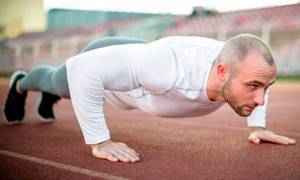
A special feature of the lats is that they are divided into two categories according to their functions. And for their uniform and high-quality development, it is necessary to include in the program exercises included in both categories.
The most effective exercises for developing back muscles
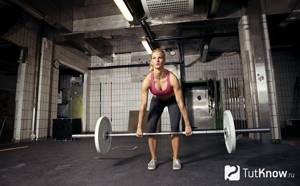
Now we will tell you about the most effective movements that will answer the question of how to pump up a wide back at home.
- Classic pull-ups.
This is one of the best exercises to strengthen the lats. Hands on the horizontal bar should be located approximately at the level of the shoulder joints. Also, to emphasize the load on your back, your thumbs should not wrap around the bar. As a result, the biceps will be switched off from work and the load will shift to the latissimus. An equally important aspect of performing the exercise as effectively as possible is that. The slower you pull up, the more your muscles are stressed. Start with four sets of 10 repetitions each. - Pull-ups, narrow grip.
Pull-ups again, but this time you should use a narrow grip, in which the distance between the palms is no more than 15 centimeters. Also remember to keep your thumbs away from the bar. When your chin is above the horizontal bar, pause and start moving in the opposite direction. This exercise will actively engage the upper part of the latissimus muscles. Perform four sets of 12 repetitions. - Hyperextension.
This movement is performed without weights and allows you to perfectly strengthen the long back muscle. In the gyms there are special exercise machines for this exercise, and at home you can use a bed, you just need to securely fasten your legs. Lie on your stomach with your body hanging over the edge of the bed. After this, begin to lower your torso down, and then return to the starting position. The pace of the movements is slow. When your muscles are strong enough, you can use weights, say, dumbbells. Perform three sets of 15 repetitions. - Exit by force.
You need to return to the horizontal bar again. Let us immediately warn you that this movement is difficult, but very effective. From a technical point of view, exit by force turns out to be simpler in practice than it seems from the outside. While hanging on the horizontal bar, you should swing your legs slightly forward. This will give you the momentum you need to complete the exercise. When starting to master the exercise, do not perform it at a slow pace, but literally fly onto the bar. Gradually, the speed must be reduced and the movement must be performed slowly, excluding the swing of the legs and working only with the muscles of the arms and back. - Dumbbell rows.
If you have dumbbells, you can pump up your back even better. A great exercise for this is dumbbell rows. With your knees slightly bent, lean your body forward. Sports equipment is held in hands that are lowered down. Start performing dumbbell rows towards your waist, and this should be done only with the help of your back muscles. Perform four sets of 12 repetitions. - One-arm dumbbell rows with support.
This movement is isolated and in many ways similar to the previous one. You need to place one leg on a support, for example, a bench. Also rest against it with the same hand. The dumbbell is in the second hand on the side of the supporting leg. The body is tilted forward until it is parallel to the ground. From this starting position, begin to perform rows of sports equipment in the direction of the waist. - Deadlift.
If you want to know how to build a wide back at home, then if you have a barbell, you can perform such a great movement as the deadlift. At the same time, the exercise can be done with dumbbells. Beginning athletes can safely start with this particular sports equipment, since as long as they have the opportunity to progress the load, the muscles will also grow. Take a standing position with your feet at the level of your shoulder joints. The knee joints need to be slightly bent, and the back has a natural arch in the lumbar region. Dumbbells are in the hands and lowered down. From this starting position, begin to lean your body forward until it is parallel to the ground. Sports equipment should move close to the body. Having reached the final position of the trajectory, start moving in the opposite direction.
Here are all the basic moves you can do at home.
After completing the main part of the training, you should do some stretching, which will have a positive effect on muscle growth. When the previous load turns out to be easy for you, begin to increase everything, while reducing the number of repetitions. Also watch your diet, as about 50 percent of your success or failure depends on it. Knowing how to pump up a wide back at home, you can build a beautiful body, making it more attractive. How to pump up your back at home, see here:
